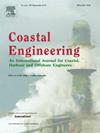GreenSurge: An efficient additive model for predicting storm surge induced by tropical cyclones
IF 4.2
2区 工程技术
Q1 ENGINEERING, CIVIL
引用次数: 0
Abstract
Storm surge is one of the main components of sea level beyond coastal flooding induced by intense storm events such as tropical cyclones (TCs). This component can be estimated using dynamic numerical simulations that consider both the inverse barometer effect induced by pressure gradients and wind setup. However, the dynamic approach can be computationally demanding and time-consuming, particularly for being included in early warning systems of resource-constrained communities. In this study, we introduce as an alternative, a novel additive hybrid model known as GreenSurge. This model relies on the generation of a library of sea-level responses to unitary wind sources from any direction, along with the assumption of a linear dynamics framework for the summation of the spatial and temporal sea-level responses, facilitating the efficient reconstruction of storm surge at regional-to-local scales. To showcase the capabilities of GreenSurge, we have implemented the method in the Pacific Island of Tongatapu (Tonga) to predict the storm surge induced by several TCs and compare its capabilities against dynamic numerical simulations and available tide gauge data. Given its similar accuracy (errors less than 10% of the maximum storm surge value) and higher computational efficiency when compared with dynamic hydrodynamic models, GreenSurge has proven to be a great alternative for reconstructing historical time series, feeding coastal flooding models, or even analysing climate change scenarios.
GreenSurge:预测热带气旋风暴潮的有效加性模型
风暴潮是热带气旋等强风暴事件引起的沿海洪水以外海平面的主要组成部分之一。该分量可以使用动态数值模拟来估计,该数值模拟考虑了气压梯度和风力设置引起的逆气压计效应。但是,动态方法在计算上要求很高,也很耗时,特别是在资源有限社区的早期预警系统中。在这项研究中,我们介绍了一种新的附加混合模型,称为GreenSurge。该模型依赖于生成来自任何方向的单一风源的海平面响应库,以及对时空海平面响应总和的线性动力学框架的假设,从而促进了区域到局部尺度上风暴潮的有效重建。为了展示GreenSurge的能力,我们在太平洋的汤加塔普岛(Tongatapu)实施了该方法,以预测由几种tc引起的风暴潮,并将其能力与动态数值模拟和现有的潮汐计数据进行比较。与动态水动力模型相比,GreenSurge具有相似的精度(误差小于最大风暴潮值的10%)和更高的计算效率,已被证明是重建历史时间序列、提供沿海洪水模型甚至分析气候变化情景的一个很好的替代方案。
本文章由计算机程序翻译,如有差异,请以英文原文为准。
求助全文
约1分钟内获得全文
求助全文
来源期刊

Coastal Engineering
工程技术-工程:大洋
CiteScore
9.20
自引率
13.60%
发文量
0
审稿时长
3.5 months
期刊介绍:
Coastal Engineering is an international medium for coastal engineers and scientists. Combining practical applications with modern technological and scientific approaches, such as mathematical and numerical modelling, laboratory and field observations and experiments, it publishes fundamental studies as well as case studies on the following aspects of coastal, harbour and offshore engineering: waves, currents and sediment transport; coastal, estuarine and offshore morphology; technical and functional design of coastal and harbour structures; morphological and environmental impact of coastal, harbour and offshore structures.
 求助内容:
求助内容: 应助结果提醒方式:
应助结果提醒方式:


